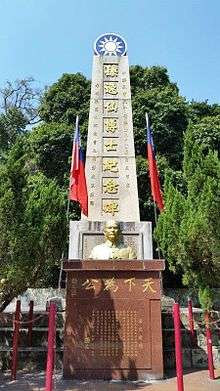Red House (Hong Kong)
Hung Lau is a house built between 1905 and 1910 on former farmland in Pak Kok, Tuen Mun, Hong Kong. It was used by the Revive China Society (興中會) as a base for revolutionary activities against the Qing dynasty.[1]
| The Red House | |
|---|---|
紅樓 | |
Hung Lau | |
%26groups%3D_0b53bfec08b04ffa97618e0fec0c28fb45823d31.svg)
| |
| Alternative names | Hung Lau |
| General information | |
| Classification | Grade I declared monument |
| Location | Pak Kok, Tuen Mun |
| Country | Hong Kong |
| Groundbreaking | 1905 |
| Completed | 1910 |
| Known for | Outpost of the Revive China Society |
| Red House | |||||||||
|---|---|---|---|---|---|---|---|---|---|
| Traditional Chinese | 紅樓 | ||||||||
| Literal meaning | Red House | ||||||||
| |||||||||
Nature and locale

It is a Grade I historic building since 2009,[2] a classification which does not mandate preservation. It is named for its red-pigmented external surface rendering. The two-storey house is a mix of Chinese and Western influences. It is near the Tuen Mun Public Riding School, Butterfly Estate and Castle Peak.
History
Hong Kong merchant and financier of the original China Daily Li Ki-tong, who met Dr. Sun Yat-sen in 1895 and joined the Revive China Society in 1900, provided his farm to the Society as its secret base in 1901.[3] The farm provided cover and sustenance to the group for the planning of its coup attempts in Guangzhou and Wuhan.
In 1968, a proposal was made by lawmaker Ellen Li, specifying that a memorial garden and museum be set up in the area. The proposal was declined because British colonial officials did not want to collaborate with the pro-Taiwan Sun Yat-sen Memorial Association of Hong Kong, a group which made repeated requests for the conservation of the site. In the 1990s and early 2000s, the District Council of Tuen Mun proposed spending HKD $86M to restore the area, but it did not move forward.[4]
The house and garden remained in the Li family as of 2011[4] but was subject of a controversial sale to a mainlander in November 2016 for HKD $5M.[5] In February 2017, 300 people protested the demolition of a wall by the new owner.[6] It was declared a proposed monument by the Antiquities Advisory Board on 9 March 2017 to protect the building from further modifications and damages, for a period of one full year.[7] In October 2017, the owner applied for a subsidy from the government, which mandated that the building should not be demolished or sold 10 years after restoration.[8] In December 2017, the government decided to not promote the building as a declared monument, due to lack of concrete evidence linking the building to the 1911 revolution.[9]
Since the Double Tenth Festival in 2018, celebrations of the Republic of China National Day and Establishment Day are obstructed by the owner that the participants are not allowed to enter the grounds.
Sun Yat-sen Commemorative Garden
Lying on the same plot of land and adjacent to the house is a garden commemorating Dr. Sun Yat-sen and one of few places in Hong Kong where the flag of the Republic of China is hoisted continuously.[10] It was built in 1983, and contains an obelisk and statue of Sun Yat-sen.
The garden has been vandalized several times; in 2002, the statue or Dr. Sun Yat-sen was vandalized, and three Arenga trees were cut down. In 2014, the statue and monument were vandalized again, the signboard and a few steles were broken, and many Republic of China flags were torn.[11]
According to Johnny Mak, District Councillor of Yuen Long, ceremonies have happened at the garden and Hung Lau every January 1 (Establishment Day) and October 10th (National Day) since 1968,[10] with Mak currently serving as the primary organizer of the October 10th ceremonies.[12] Mak is the chairman of the Highwise Yuen Long Service Centre, the group that manages the memorial garden.[4] Ceremonies have been attended by pro-Taiwan people, as well as officials from the Chung Hwa Travel Service, the precursor of TECO in Hong Kong.[4]
References
- "List of historic buildings and structures in association with Dr. Sun Yat-sen and the revolutionaries in Hong Kong" (PDF). Antiquities Advisory Board. Retrieved 18 February 2017.
- "Government highly concerned about the condition of Hung Lau". www.info.gov.hk. Retrieved 28 April 2020.
- "Revolutionary Activities of Li Ki-tong" (PDF). Antiquities and Monuments Office, HKSAR Government. Retrieved 18 February 2017.
- Ng, Joyce (28 March 2011). "Revolutionaries' secret base left to decay despite heritage". South China Morning Post. South China MOrning Post Publishers Ltd. Retrieved 18 February 2017.
- Cheng, Kris (17 February 2017). "Lawmaker suspects political reason behind sale of Tuen Mun property linked to China's 'founding father'". Hong Kong Free Press. Retrieved 18 February 2017.
- "Officials in talks with owners of historic Red House amid demolition fears". South China Morning Post. 21 February 2017. Retrieved 28 April 2020.
- Cheng, Kris (9 March 2017). "House linked to China's 'founding father' granted temporary protective status after suffering further damage". Hong Kong Free Press. Retrieved 10 March 2017.
- "Historic Hong Kong Red House set to be preserved for 10 years". South China Morning Post. 26 October 2017. Retrieved 28 April 2020.
- "Historic Red House misses out on protection from demolition". South China Morning Post. 8 December 2017. Retrieved 28 April 2020.
- "Double Tenth day: the disappearing flags of the Republic of China in Hong Kong". South China Morning Post. Retrieved 28 April 2020.
- "Index". Zhongshan Park in the World. Retrieved 28 April 2020.
- "Hong Kong marks Double Tenth and old soldier dreams of one China". South China Morning Post. 11 October 2017. Retrieved 29 April 2020.
External links
See also
| Wikimedia Commons has media related to Red House (Hong Kong). |